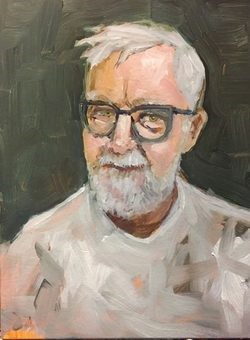Wednesday, June 16
7:00 – 8:30 pm
Inspired Collaboration: Bob Keller, Elsie Myers Martin & Guest Poets

Art and whimsy mingle in this inspired collaboration of visual art, poetry, dance, video and Zoom. Artist Bob Keller’s illustrated alphabet animals inspired poetic responses from classmates around North America, while choreographer Elsie Myers Martin’s traditional improvisational work with dancers flowered once she had to overcome the limitations imposed by COVID.
After presentations by Bob and Elsie, there will be a Q&A that also includes contributing poets. Join in for this light and entertaining evening as we explore creativity and the beauties of collaboration.

Artist Bob Keller started working on an animal alphabet book for Etta, his first grandchild. “And all subsequent grandchildren,” Bob said, “because if I finish this one, I’m not going to want to do another. I just need to get it done before she goes to college.”
He finished well ahead of schedule. Peg Sweitzer spotted some of his paintings and hatched the idea of pairing each letter with a verse. An informal solicitation went out to classmates who were known poets—or at least former English majors—which resulted in more than enough poems to cover all 26 letters.
“One of the things I love most about Carleton is the multidimensional people,” Peg said. “Our classmates are so multi-talented and still don’t take themselves too seriously. This is what I want to celebrate in this program of light entertainment. I did not give the poets any parameters when I asked them to write. The poems I got are short, most are very appropriate for children, and some are funny.”
Bob said, “I’m really pleased at the response we got from the poets in our class. As an editorial illustrator, my work was almost always collaborative. I would respond to writers in order to create illustrations that would break up the text and draw the reader into the article. It’s been fun to work the other way around with writers responding to my art.”
To showcase the variety, Peg didn’t necessarily choose what she thought was the “best” poem when she received more than one for a particular creature. As Bob’s images are revealed, we’ll see the text of each poem along with hearing the contributing writer read.

During the COVID summer, Elsie Myers Martin missed working with certain dancers whose movement qualities make them very much partners in the creation of her choreography. Seeking an environment that would be safe for her as well as for a dancer, she asked one to work with her outside and socially distanced.
Elsie describes how this process evolved into a series of videos she calls “Poetry-in-Motion”:
Our first session at Lake Harriet Gardens in Minneapolis involved a lot of experimenting. Together the dancer and I picked locations that we found particularly beautiful. I directed her to use the flower or tree as inspiration for her movement improvisations and then encouraged those movements that I particularly liked. We usually worked for about an hour at a time.
Previously, I used video only to document my dances, not as an art medium. Here, I made short video clips with my iPhone camera and then would edit them with iMovie. In later sessions with other dancers, we continued to experiment with location, movement realms, clothing and lighting. Each completed video is two to four minutes.
I do not use music when choreographing; I do not want to use someone else’s creation to directly inform my own vision. As you will hear in this program, original soundtracks ranged from birds singing to mowing, background talking, wind and passing cars. Philip Brunelle, the well-known music director at Plymouth Congregational Church, suggested that music could be added by Laura Caviani (who teaches jazz piano at Carleton) and her trio. I’ll show one example they recorded after watching the video once and then improvising a score while watching a second time.
My composition mentor encourages viewing the dance with no pre-conceived knowledge of what it is about. Of course, there is no right way to look at art. Art is as much about what the viewer brings to the experience as it is about the intentions of the artist and the collaboration of other creators.